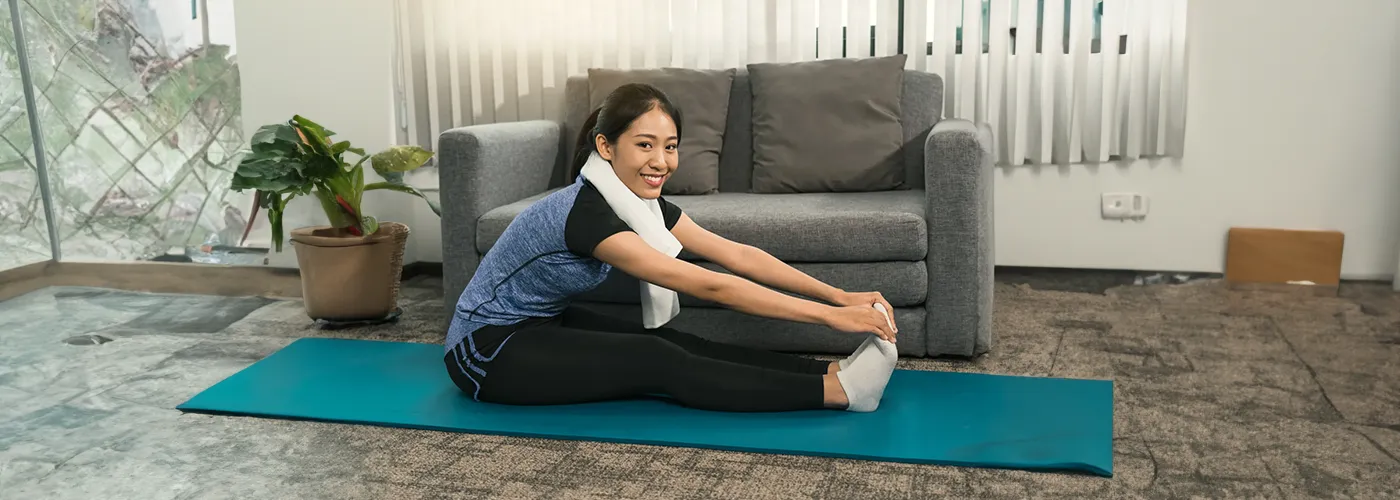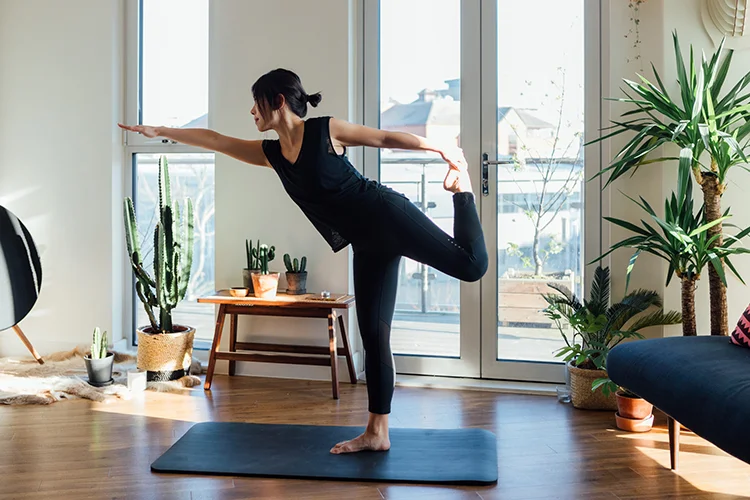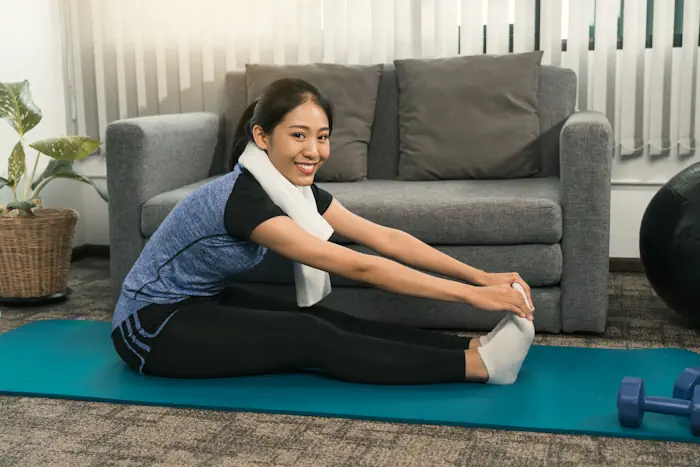High-intensity interval training (HIIT) workout for women is revolutionising the fitness world, offering a dynamic approach to exercise that blends intensity with efficiency.
Tailored to meet the unique physiological needs of women, this high-intensity interval training method promises rapid results, burning calories and sculpting muscles in short, powerful bursts.
What Is an HIIT Workout?
High-intensity interval training is a specialised workout format that constitutes intermittent maximal or supramaximal exercise, interspersed with recovery periods.
As an alternative to traditional endurance training, HIITs require less time and permit a greater volume of high-intensity exercises than continuous exercising.
Characterised by shorter durations than continuous aerobic training, HIIT workouts are highly effective in accomplishing metabolic, cardiovascular, and skeletal muscle improvements.
Furthermore, HIIT workouts are anaerobic—which means they do not utilise oxygen as their primary energy source. Rather, they mostly rely on creatine phosphate to deliver the power required for explosive, rapid-fire activity.
Why Are HIIT Workouts Effective?
The WHO guidelines recommend that adults engage in moderate-intensity physical activity for a minimum of 150 minutes per week of low to moderate intensity exercises to maintain optimal cardiovascular health.
HIIT workouts offer an effective way to adhere to these recommendations as they may be modified for individuals of all fitness levels and special medical conditions.
In practice, HIIT exercises can be engaged in across different exercise modes, such as swimming, cycling, walking aqua training, elliptical cross-training, etc.
For the most part, HIIT delivers fitness benefits that are comparable to continuous endurance workouts, however, in shorter periods of time. This is primarily due to the fact that HIIT typically burns more calories than traditional workouts because of their vigorous contractile.
Generally, there are multiple ways to engage in HIIT.
However, the principal concept is to work hard for a few seconds to get one’s heart rate up, and then relax to recover, and repeat the cycle. This process is in stark contrast to traditional cardio where one works out at a moderate and steady pace for extended periods (typically 30 minutes or more).
What Are the Benefits of HIIT Workouts?
HIIT workouts are becoming increasingly popular due to their potentially significant effects on exercise capacity and minimal-time requirements. Other benefits of HIIT workouts include:
- Helps with fat loss: HIIT workouts help produce excess post-exercise oxygen consumption (EPOC), which ensures the fat-burning process continues even after exercising.
- Burns more calories in a short period: HIIT workouts help burn a high number of calories in a short amount of time. They may burn the same number of calories in a 20-minute workout as a 40-minute cardio workout.
- Increases metabolic rate: The intense nature of HIIT exercises increases heart rate, which, in turn, elevates metabolism. This may lead to increased energy and preservation of lean body mass.
- Helps increase muscle mass: HIIT workouts may also increase muscle mass especially when combined with resistance training.
- Strengthens the heart and improves blood pressure: HIIT workouts help the heart pump more blood with each beat. Consequently, this improves blood flow and reduces inflammation and the risk of heart disease.
- Helps improve overall stamina: HIIT is based on anaerobic system, but it also offers improvement of maximal oxygen consumption (VO2max), the indicator of cardiorespiratory fitness. This means, the higher your VO2max value, the higher your endurance.
- Helps reduce blood sugar levels: HIIT training helps promote better blood sugar regulation since it makes one’s body more sensitive to insulin and causes the body to demand glucose for energy. As a consequence, one’s blood sugar levels stabilise, reducing the risk of developing diabetes.
- Improves overall health: HIIT improves fat burning after workout and enhance skeletal muscle metabolism. This consequently reduces the risk of heart-related illness substantially and manifests appreciable anti-aging benefits at the cellular level in skeletal muscle.
What Are the Types of HIIT Exercises?
HIIT workouts are ideal for busy women who desire to fit exercises into their packed schedules. This is because of their convenient and time-efficient nature as they can be completed in as little as 10-30 minutes.
Here is a list of the most effective HIIT workouts (with their corresponding steps) that busy women may try at home.
To perform a burpee HIIT exercise:
- Crouch down with your feet further than shoulder-width apart. Subsequently, place your hands on the floor.
- With your body weight in your hands, proceed to kick both feet out behind you. Afterwards, rest on the balls of one’s feet.
- Jump forward and propel your body up to land in a standing position.
- Repeat the motion for 20 seconds at high intensity, with 10-second rest breaks in between.
To perform a push-up:
- Commence in a plank position, with your shoulders over your wrists, with your legs out behind you.
- Contract your abdominal muscles and keep the back straight.
- As you lower and exhale, ensure to bend your elbows outward to the sides.
- If you could not perform the aforementioned steps on your feet, start on your knees.
- Eventually, you will be able to execute the standard push-ups as your strength increases.
- Repeat the exercise for 20 seconds at high intensity, with 10-second rest breaks in between.
This HIIT workout targets one’s shoulders, hamstrings, triceps, and quads:
- Get down into a high plank, keep your back straight and head in line with the spine.
- Ensure your hands are directly beneath your shoulders, arms fully extended, and your fingers facing forward whilst slightly spread apart. This position works on your upper and lower abs.
- Pump your knees toward your chest one at a time. Try not to rock your torso from side to side but breathe through it.
- Repeat the motion for 20 seconds at high intensity, with 10-second rest breaks in between.
This HIIT workout is characterised by three main steps, namely:
- Stand with your feet together and arms at the sides.
- Next, jump to your feet out to the sides and raise your arms above your head.
- Immediately, reverse this motion back to the starting position.
- Repeat the motion for 20 seconds at high intensity, with 10-second rest breaks in between.
This exercise principally targets a woman’s hamstrings, thighs, quads, and glutes:
- Stand with feet hip-width apart, hinging at the knees to reach a squat position. Ensure that your knees track over your toes and do not extend past.
- With the weight on your heels, push back to standing, squeezing your glutes at the top.
To effectively perform jump squats that target glutes, hips, quads, and hamstrings:
- Lower down into a squat position, with your feet hip-width apart.
- Explode upwards by pushing through your heels while using your glutes to jump.
- Try to extend your legs fully at the top of the jump.
- Land in a squat position and repeat.
A jump rope HIIT exercise involves:
- Jumping a rope for approximately 20 seconds at a high intensity, subsequently followed by about 10 seconds of rest.
- Repeat this cycle of 8 rounds or a total of 4 minutes.
- Then cool down for about 5 minutes with stretching or light cardio exercise.
Kettlebells are specialised weights utilised in HIIT exercises that are shaped like a ball with a handle on top. Kettlebells are very dynamic with a sub-maximal load, allowing one to move through a wide range of motion, thereby targeting multiple muscle groups.
Kettlebell HIIT workouts usually entail one exercise format, performed for about 20 seconds for 8 rounds/4 minutes with 10 seconds of rest in between. For example, you can perform:
- Right-hand kettlebell swings for 20 seconds.
- Two-handed kettlebell swings for 20 seconds.
- Left-hand kettlebell swings for 20 seconds.
- Alternating hands kettlebell swings for 20 seconds.
Russian twists may help strengthen the obliques and the spine. They can be performed in two steps with kettlebells:
- Sit on the ground and bring your legs out straight. Then lean back slightly so your torso and legs form a V-like shape whilst bracing your abdominal wall to engage your core.
- Balance and keep your legs stationary whilst twisting your torso from side to side.
- Repeat for 8 rounds that last about 20 seconds at a high intensity, subsequently followed by 10 seconds of rest.
- At the end of the exercise, rest for 5 minutes with stretches and light cardio exercises.
Lunge HIIT exercises target one’s core, quads, and glutes:
- Step back into a reverse lunge with your left leg from a standing position.
- Push through your right heel to come back to a standing position, then follow through with your left leg to raise it in front at 90 degrees.&
- Then repeat the cycle.li>
Busy women can explore lunge jumps in three steps:
- Slowly warm up by stretching or light cardio.
- Then, perform non-stop lunge jumps for one minute, followed by one minute of rest.
- Repeating the exercise for 8 rounds with rest in between.
Plank HIIT workouts that strengthen the core and abdomen, typically involve four steps, namely:
- Position your hands and knees in a tabletop position, then lower down to your forearms with your elbows stacked beneath your shoulders.
- Form a straight line from your head and neck to your feet whilst being supported by your heels.
- Hold this position for 20 seconds at a high intensity, then rest for 10 seconds.
- Repeat the exercise for about 8 rounds, or at least 4 minutes.
- Lie down on your back with your knees bent and hands behind your head.
- While keeping your chin angled towards the sky, utilise the core to sit up until your elbows touch your knees. Subsequently, lower back down to the ground and repeat.
- Perform this motion for about 20 seconds at a high intensity, subsequently followed by 10 seconds of rest.
- Repeat this for 8 rounds, or at least 4 minutes.
- Start from a standing position, then raise and lower one knee at a time as if running in place.
- Bring your knees to the same height as your hips whilst keeping your thighs parallel to the ground.
- Perform this cycle for about 20 seconds for 8 rounds at high intensity with 10 seconds of rest between each round.
As a plyometric exercise, box jumps can be executed in four steps, namely:
- Stand in front of a box/platform that is between 12-18 inches high.
- With your feet slightly apart, you should push your hips back and swing your arms.
- In one explosive move, swing your arms forward, spring up land on the box, and get down off the box with one foot at a time.
- Perform this action with maximum effort for about 20 seconds for 8 rounds, with 10 seconds of rest between each round.
HIIT for beginners: Tips to get started
Many women tend to fear HIIT workouts because they appear difficult from the outset. However, here are some tips we can share to overcome this phobia whilst considering the duration, intensity, frequency, and recovery intervals of any HIIT exercise regime. For example:
- Start at a pace that suits your current fitness level, gradually increasing the intensity and duration as your fitness improves. The American College of Sports Medicine recommends that the HIIT workout intensity to be at least 70-90% of one’s estimated maximal heart rate.
- Always listen to your body, and do not push yourself too hard too soon. Remember, excessive pushing during high-intensity workouts may lead to burnout or injury.
- Maintain proper form during HIIT exercises to prevent injuries and maximise effectiveness. Good form targets the right muscles and minimises the risk of strains or sprains.
- If you are unsure about your form, consider working with a fitness professional or using instructional videos.
- Use a ratio of exercise to recovery. For instance, a ratio of 1:1 might be a 1-minute high intensity followed by a 1-minute recovery.
Frequently Asked Questions (FAQs)
HIIT workouts are stressful to the body and require recovery time. As such, it is not advisable to perform them every day.
Because HIIT workouts are more exhaustive than average endurance workouts and require longer recovery periods, it is not advisable to perform them more than once one day.
Generally, it is recommended that one schedules 2 or 3 HIIT sessions per week, with rest days in between.
Between HIIT workouts, it is also advisable to fit some long-duration aerobic training into the week, if possible. For example, jogging or jumping rope at a light pace one day per week.
Generally speaking, HIIT workout sessions should not take more than 30 minutes (while also considering the breaks in between).
Remember, these are intense sessions and burn more calories per minute of exercise than conventional aerobic training. Furthermore, always warm up to prevent injury and climax with a gentle cool-down to gradually lower your heart rate.
Since HIIT workouts are very intense, one cannot simply perform them for elongated time periods. So, yes, 20 minutes per day should suffice. Remember, you can always adjust the intensity, duration, and number of rounds depending on your fitness level and goals.
It is advisable to engage in HIIT workouts after at least 6 months of consistent exercise that involves a mix of cardio and resistance training. At this point, one can replace one cardio session with one short HIIT session, separated by two rest cycles— then gradually increase their sessions depending on their schedule.
Yes, one can do some HIIT workouts by focusing more on upper body and core exercises. Besides that, you could also switch to more non-weight bearing based exercises. For example, elliptical, rowing machine, Pilates, leg or arm cycle, swimming, and aquatic exercises.
For people previously living sedentary lifestyles with large periods of inactivity, having clearance from a physician is key before starting any HIIT workout.
Furthermore, before commencing HIIT training, it is encouraged to establish a foundational/base level of fitness. This should help when modifying the intensity and frequency of your preferred workout, with minimal risk.
Yes, they do. HIIT workouts are cardio-focused, i.e., they benefit cardiovascular fitness and health. HIIT workouts produce equal or greater improvements in blood pressure and blood sugar in contrast to other forms of cardio exercises.
HIIT workouts are characterised by intense bursts of physical activity, subsequently followed by periods of rest or low-intensity exercise. The resultant EPOC effect may increase the body’s metabolic rate and need for oxygen afterwards, which may lead to fatigue the following day.
Furthermore, after an intense workout, one’s body utilises oxygen to restore adenosine triphosphate (ATP) and repair damaged muscles and cells. So, the harder one works out, the more ATP they will use, and the more oxygen they will need to restore ATP levels after a workout.
Yes, HIIT workouts may help achieve belly fat loss and slim your waistline faster than any other workout forms like brisk walking or running. However, fat loss depends on an overall caloric deficit and HIIT exercise alone will not necessarily derive the desired results.
When combined with appropriate dieting, HIIT workouts may help a woman successfully lose one to two kg of body fat in a month. However, the amount of weight lost largely depends on the intensity and frequency of the HIIT workout.
Make an Appointment at Pantai Hospitals
Since HIIT workouts can be completed little as 10-20 minutes, busy women can still prioritise their health and fitness without sacrificing time for work, family, or other commitments.
That said, be sure to contact a trained professional to help you tailor an effective HIIT programme based on your exact aerobic and anaerobic needs and goals.
Get in touch with us to book an appointment and find out more about our Physiotherapy and Rehabilitation Services at your nearest Pantai Hospital.
Pantai Hospitals have been accredited by the Malaysian Society for Quality in Health (MSQH) for its commitment to patient safety and service quality.
This article has been reviewed by the Pantai Integrated Rehab team.

















